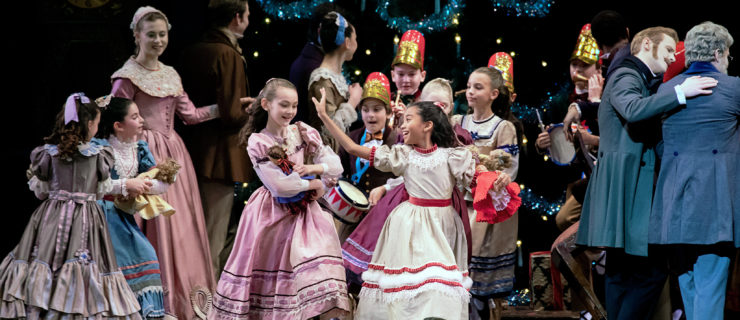The Life of a Pointe Shoe, from Factory to Stage
For professional ballet dancers, the search for the perfect pointe shoe is a lifelong quest. Even the smallest adjustment in manufacturing can make the difference between a shoe that allows a ballerina to soar and a shoe that detracts from her dancing. So what goes into creating the perfect fit? A lot of hard work, patience, and masterful attention to detail. We got the inside scoop on how a Bloch pointe shoe is made from beginning to end, and went inside one of American Ballet Theatre principal Devon Teuscher’s touch-up fittings with Bloch owner David Fox in NYC.
Teuscher meets with Fox at the Bloch store in NYC to discuss making some pointe shoe adjustments. (Marius Bugge for Bloch)
Once a dancer has ascended the ranks in the professional world, she can start to explore customizing her pointe shoes. “I started wearing the Bloch Alpha when I was 15 years old living in Vermont,” says Teuscher. “But I didn’t begin making adjustments to them until around the time I became a soloist with ABT.”
According to Fox, the number of variable adjustments a dancer could make is infinite: “There isn’t just one factor involved in solving issues,” he says. “If a dancer is too far over on her box, it could be a combination of problems with the angle of the platform, the height of the support, the length of the vamp, and the strength of the shank.” Most dancers who wear Bloch meet with shoemakers or fitters two to four times per year to discuss customization.
{“adCodes”: [], “adsOrder”: [3]}

{“product_info”: {“caption”: “Buy Now”, “product_price”: 0, “product_vendor”: false, “linkout_url”: false, “product_compare_at_price”: 0}, “headline”: “”, “credit”: “”, “description”: “u003cpu003eOnce a dancer has ascended the ranks in the professional world, she can start to explore customizing her pointe shoes. “I started wearing the Bloch Alpha when I was 15 years old living in Vermont,” says Teuscher. “But I didn’t begin making adjustments to them until around the time I became a soloist with ABT.” u003c/pu003eu003cpu003eAccording to Fox, the number of variable adjustments a dancer could make is infinite: “There isn’t just one factor involved in solving issues,” he says. “If a dancer is too far over on her box, it could be a combination of problems with the angle of the platform, the height of the support, the length of the vamp, and the strength of the shank.” Most dancers who wear Bloch meet with shoemakers or fitters two to four times per year to discuss customization.u003c/pu003e”, “caption”: “u003cpu003eTeuscher meets with Fox at the Bloch store in NYC to discuss making some pointe shoe adjustments. (Marius Bugge for Bloch)u003c/pu003e”}

{“product_info”: {“caption”: “Buy Now”, “product_price”: 0, “product_vendor”: false, “linkout_url”: false, “product_compare_at_price”: 0}, “headline”: “”, “credit”: “”, “description”: “u003cpu003eOnce the fitter has taken lots of notes on any changes required, the information and measurements are sent to Bloch’s factory in Thailand, where the process of making a pointe shoe physically begins. A shoemaker begins work on a pointe shoe by cutting out a pattern using an X-Acto knife. It takes anywhere from six weeks to two months for a trial shoe to be made.u003c/pu003e”, “caption”: “u003cpu003ePhoto by Marius Bugge for Blochu003c/pu003e”}

{“product_info”: {“caption”: “Buy Now”, “product_price”: 0, “product_vendor”: false, “linkout_url”: false, “product_compare_at_price”: 0}, “headline”: “”, “credit”: “”, “description”: “u003cpu003e Shoemakers create the sole of the shoe with a giant sole-puncher. Then, they form the toe box from a thick paste. With the sole as a base, the shoemaker begins adding layers of fabric, wrapping the shoe tightly to make each layer secure. Bloch uses the “turn-shoe” method for most of their pointe shoes, which means they’re sewn together inside out and then flipped the right way to force the seams inside.u003c/pu003e”, “caption”: “u003cpu003ePhoto by Marius Bugge for Blochu003c/pu003e”}

{“product_info”: {“caption”: “Buy Now”, “product_price”: 0, “product_vendor”: false, “linkout_url”: false, “product_compare_at_price”: 0}, “headline”: “”, “credit”: “”, “description”: “u003cpu003e Once the satin fabric that forms the shoe is trimmed and stitched together, the final touch is adding a drawstring. The pointe shoes are now ready to be shipped to ballerinas all over the world. In this case, they’ll head back to ABT in NYC for Teuscher.u003c/pu003e”, “caption”: “u003cpu003eTeuscher with Aran Bell in “Romeo and Juliet” (Rosalie O’Connor, courtesy ABT)u003cemu003eu003c/emu003eu003c/pu003e”}

{“product_info”: {“caption”: “Buy Now”, “product_price”: 0, “product_vendor”: false, “linkout_url”: false, “product_compare_at_price”: 0}, “headline”: “”, “credit”: “”, “description”: “u003cpu003eMost dancers will go through multiple versions of their shoes over the course of their careers. Teuscher is on her sixth version of the Alphau2014something Fox says is atypical. “Some dancers will be on the 23rd version of their shoe before they get what they want,” he says. “Devon knows what works for her, so she doesn’t have to.” u003c/pu003e”, “caption”: “u003cpu003eAs Odette in “Swan Lake” (Gene Schiavone, courtesy ABT)u003c/pu003e”}
A version of this story appeared in the March 2019 issue of
Dance Spirit with the title “The Life of a Pointe Shoe.”




